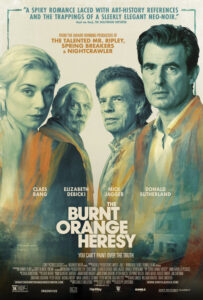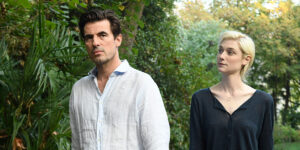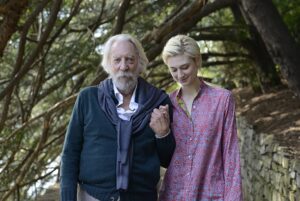Film Review: “The Burnt Orange Heresy” Turns the Art World into a Modern-Day Fable
Written by: Hannah Tran | August 20th, 2020

The Burnt Orange Heresy (Giuseppe Capotondi, 2019) 2½ out of 4 stars.
Words mean everything. At least, they do to art critic James Figueras in Giuseppe Capotondi’s latest film, pretentiously, but purposefully, entitled The Burnt Orange Heresy. James’s living depends on the equally elaborate synthesis of words to create value. The idea of truth, for James, is only secondary to this value. This mindset will ultimately determine James’s fate as he agrees to help an art collector procure a single masterpiece from the elusive artist Debney by whatever means necessary. But many of The Burnt Orange Heresy’s own words were what made me hesitant to fully buy into its wiles. Much of Capotindi’s handiwork reads as overly precise in its approach. And, like James, it often doesn’t understand that what would be best for it would be to allow for the uncontrollable, messy reality of the world to inch its way in.
Based on the eponymous novel by Charles Willeford, The Burnt Orange Heresy has its source to thank for many of its greatest strengths, as well as its greatest flaws. While technically the film struggles to translate the text-based rhythm and certain visual elements onto the screen, many of its core features, namely its characters and its story, are fully equipped to carry this material’s most existential of questions. Much of this is thanks to a near-perfect cast consisting of Claes Bang (The Bay of Silence) and Elizabeth Debicki (Vita & Virginia) as our leading players, with Mick Jagger and Donald Sutherland (Ad Astra) in supporting roles. Debicki, in particular, grows to be the heart of the film, her mysterious sincerity standing as a beacon of morality amongst the increasingly desolate, status-obsessed landscape of the art world.

And The Burnt Orange Heresy is perfectly ready to both question and criticize that world. Its contents inquire of the importance of truth in art and the way in which people ascribe value to artistic products. The Burnt Orange Heresy, moreover, considers the critic’s place in humanity relative to the artist and the average observer of art, questioning the ethical consequences of the merger of criticism and careerism. And while the third act of this film, with its myriad of questions building, initially makes a strange tonal shift, its final moments justify everything before it. Its equally sweet and dark ending provides its answer to all these questions, using the simplicity of the story to turn itself into fable.
Although The Burnt Orange Heresy struggles to overcome its overly neat dialogue and structure and ends up producing a visually colorless film about a handful of colorful characters, those characters turn this seemingly ordinary tale into something that I can only assume will linger in my mind long after watching. As it explores the dark nature of over-ambition and human greed, it also showcases how basic human honesty and sympathy can outlast any material good.


